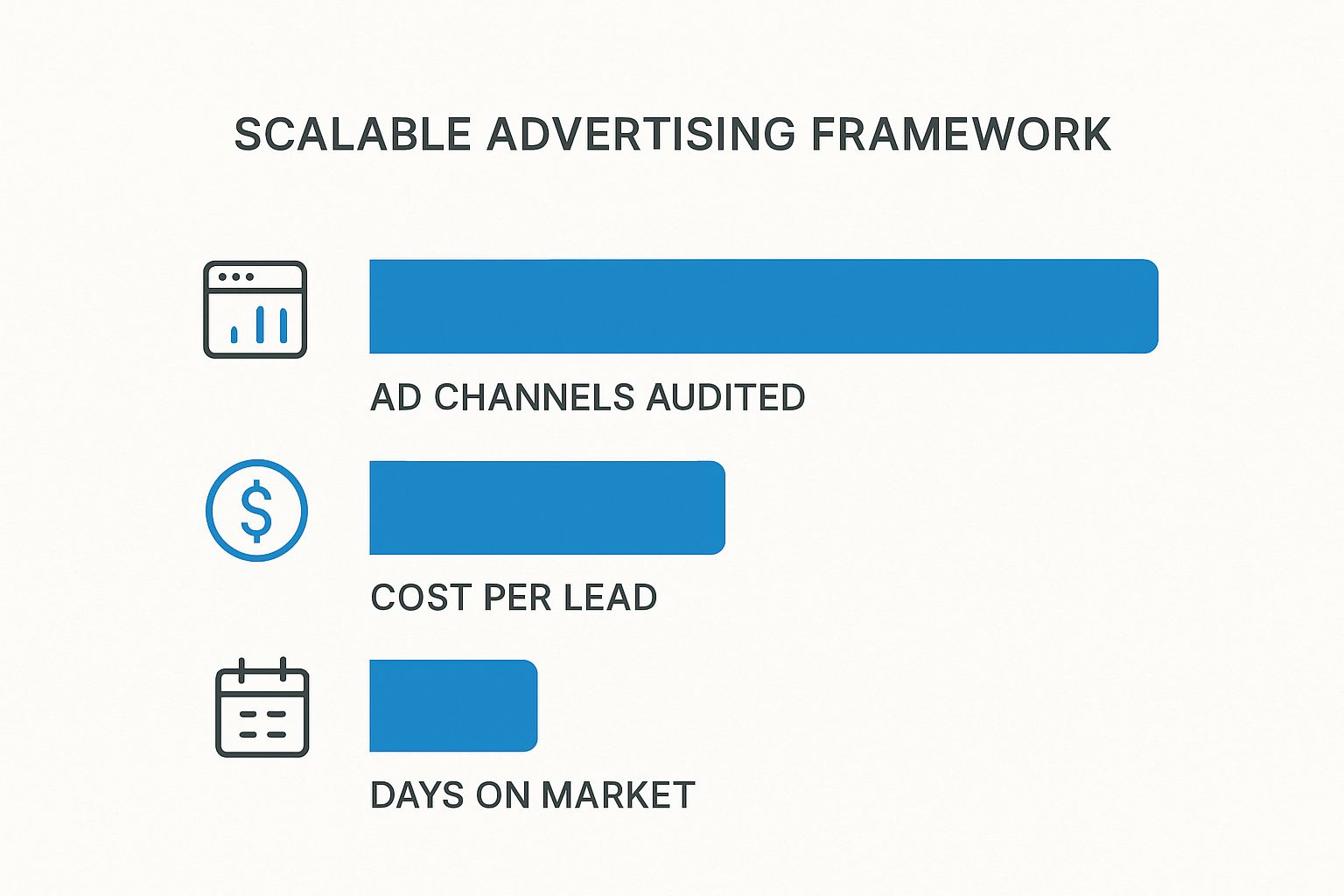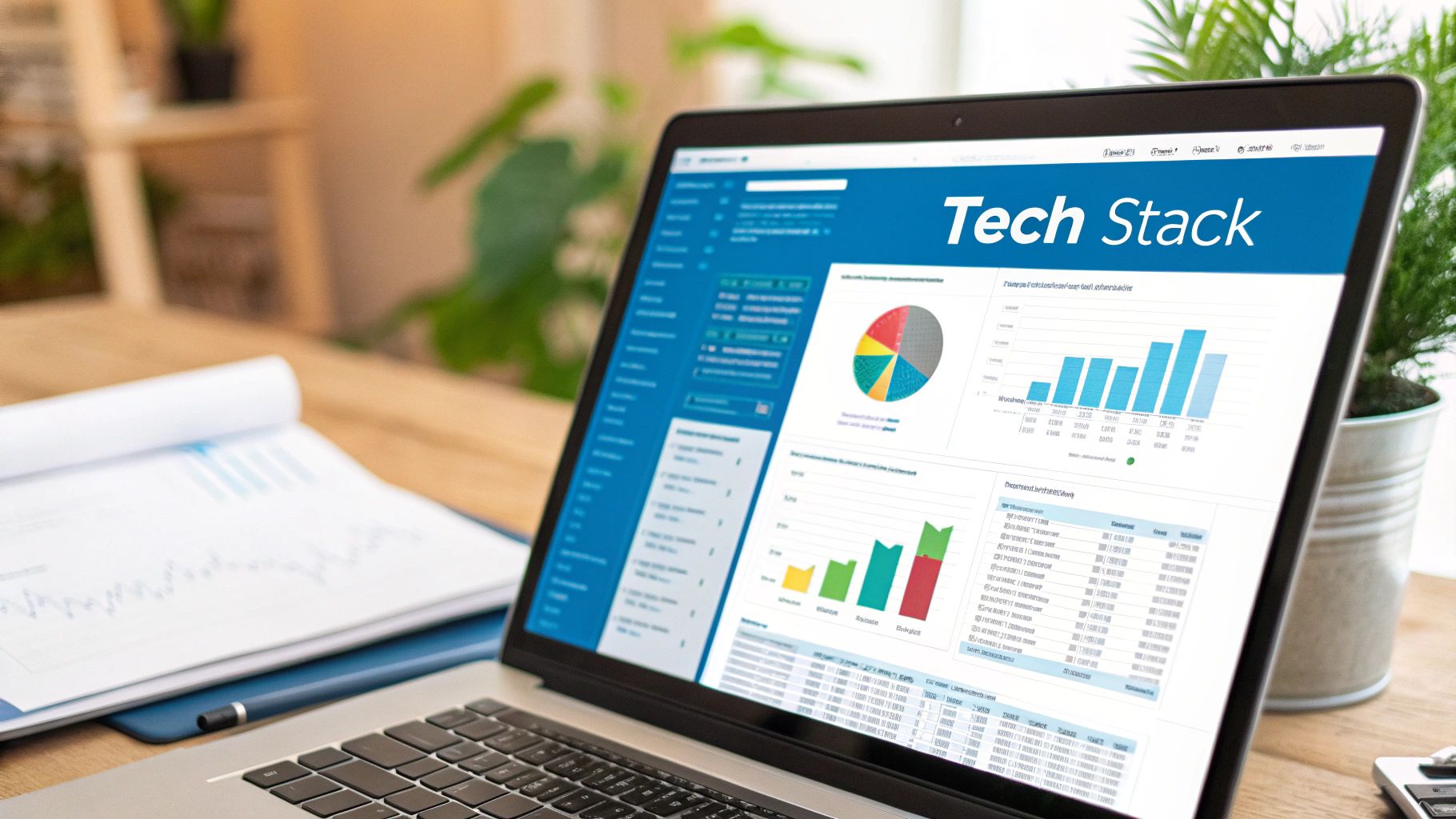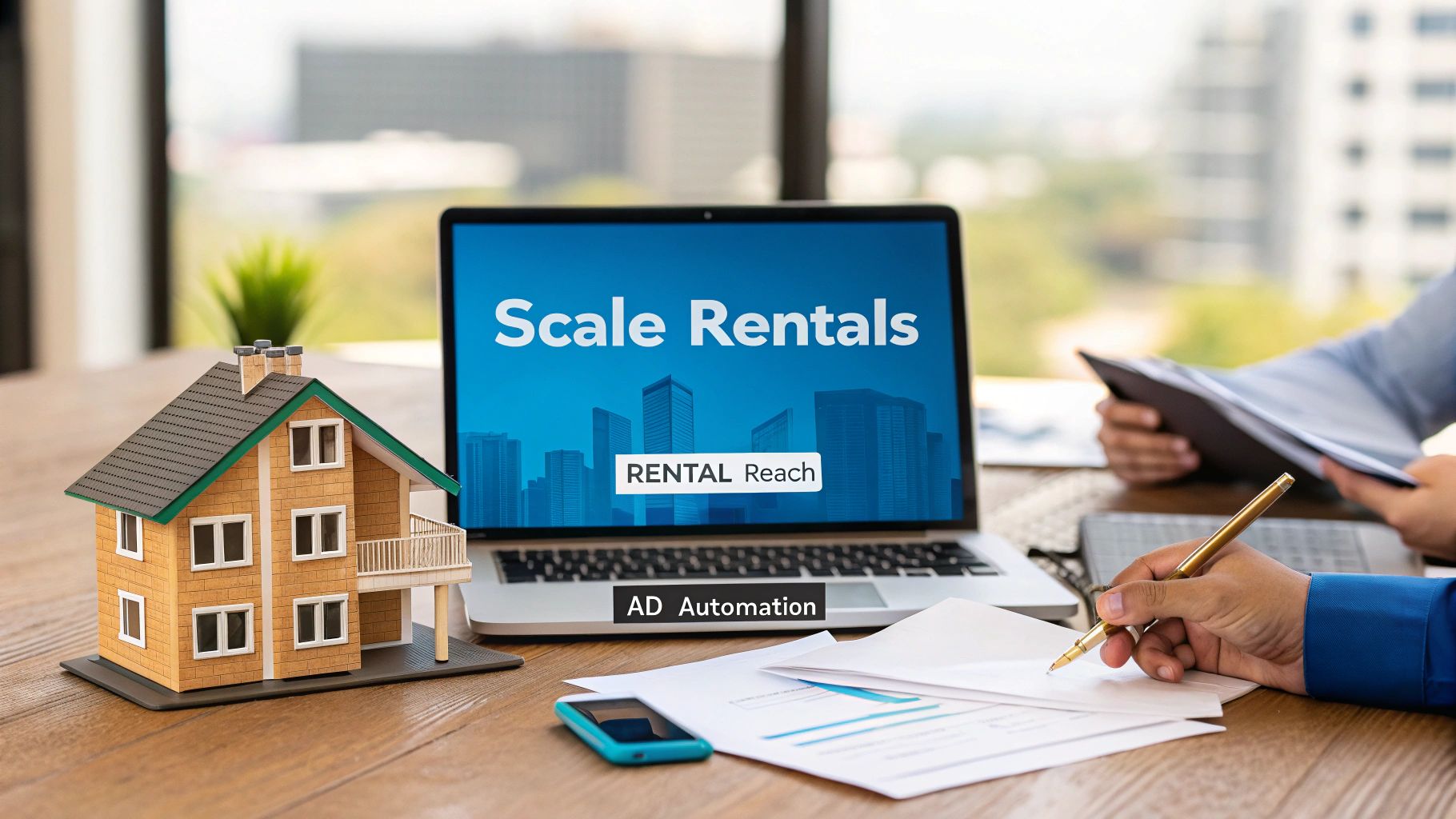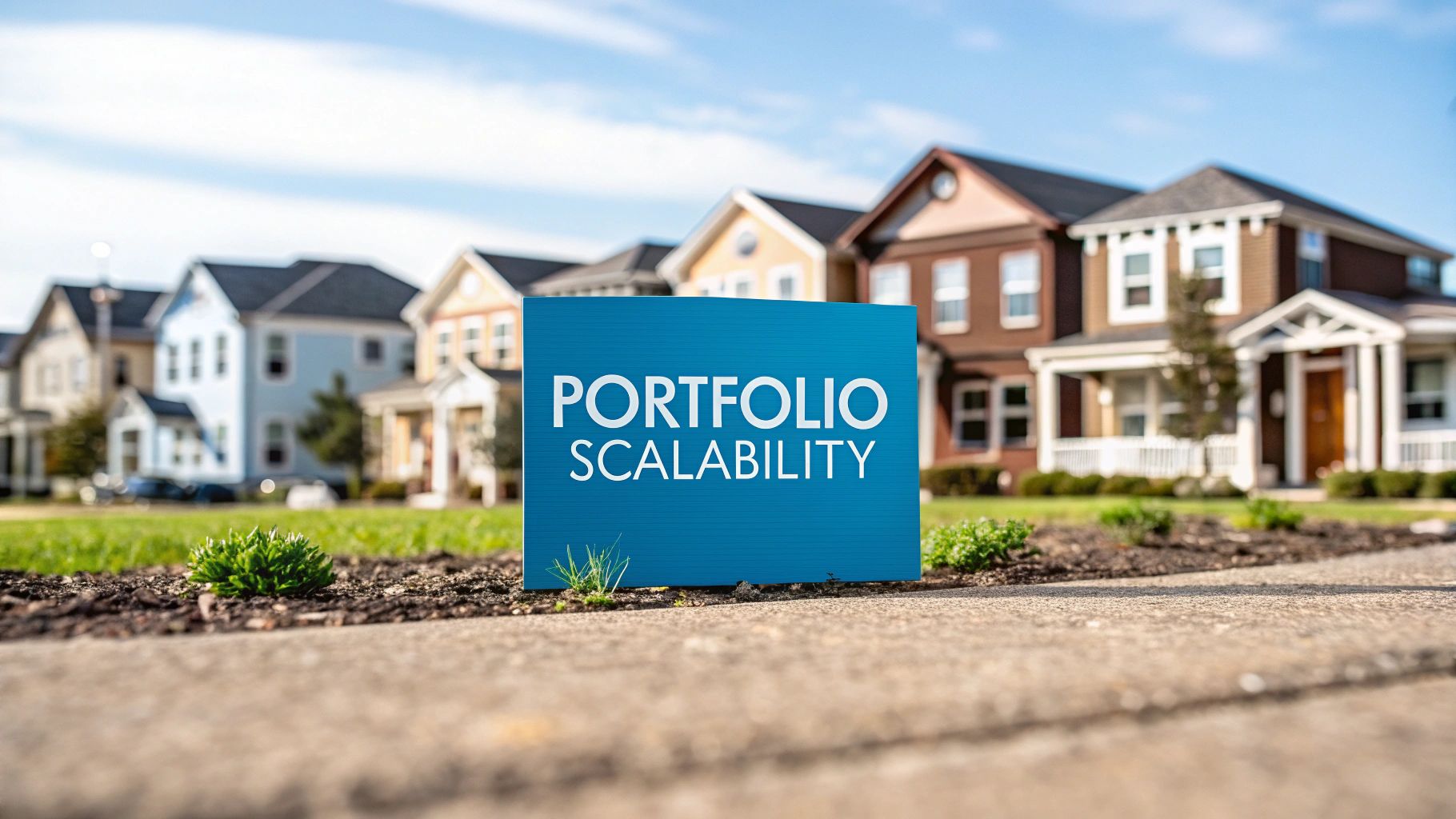A scattered approach to advertising rental properties is a direct threat to revenue, especially when managing a large portfolio. For enterprise-level property management companies, a smart, repeatable, and scalable system is the only way to minimize vacancy loss and maximize portfolio performance.
Building a Scalable Advertising Framework for Enterprise Portfolios
For property managers overseeing hundreds or thousands of units, a reactive, one-off advertising approach multiplies vacancy costs across the entire portfolio. The key to profitability is a centralized, data-driven framework built to scale. Every day a unit sits vacant is a direct hit to your net operating income. A disorganized strategy guarantees revenue leakage.
The objective is to move from scrambling at every vacancy to a proactive engine that predictably generates a pipeline of qualified leads. Mastering lead generation advertising is the foundation for creating this consistent, high-velocity leasing machine.
Conduct a Portfolio-Wide Advertising Audit
Before optimizing, you need a clear baseline of what’s working—and what's not. A portfolio-wide audit reveals wasteful spending and hidden opportunities, moving beyond simple cost analysis to measure true performance.
Dig into the critical metrics that directly impact your operational efficiency and revenue:
- Channel Performance: Which Internet Listing Services (ILSs) or paid channels are delivering qualified applicants, and which are just generating noise?
- Cost Per Application (CPA): Move beyond Cost Per Lead (CPL). Calculate the true cost to acquire a qualified application from each source. This identifies which channels deliver genuine ROI.
- Lead-to-Tour Conversion Rate: This KPI is a critical indicator of operational efficiency. It measures how effectively your advertising and initial response systems convert interest into a scheduled showing. A low rate signals a breakdown in ad copy, visuals, or lead response speed.
- Days on Market (DOM): Analyze the average DOM for properties advertised on different channels. This draws a direct line from ad spend to leasing velocity.
At enterprise scale, a 1% improvement in your lead-to-tour conversion rate can recover hundreds of thousands of dollars in annual revenue by reducing vacancy days across your portfolio.
This infographic breaks down the difference between a scattered approach and a strategic, scalable framework.

The numbers make it clear: a systematic process not only lowers advertising costs but also drastically reduces the time your properties sit empty, directly boosting your NOI.
Develop a Centralized Asset Library
Consistency is paramount for scaling operations across multiple markets. A centralized digital asset library ensures every listing—whether in one city or ten—maintains professional brand standards and enables teams to list new vacancies with speed and precision.
This library is a non-negotiable component of modern leasing operations. It must include:
- Standardized Photography Guidelines: Mandate professional, high-resolution images for every unit. Implement a required shot list (e.g., two kitchen angles, one of each bedroom, key amenities) to ensure uniformity and quality control.
- Video Tour Templates: Standardize the format for video walkthroughs, including branded intros/outros and consistent callouts for key features, to create a uniform prospect experience.
- Pre-Approved Ad Copy: Build a repository of compelling, compliant, and A/B tested listing descriptions. Create templates for different property types (e.g., SFR, 2-bedroom multifamily) that highlight amenities proven to perform well in specific markets.
Systematizing assets eliminates the guesswork and delays that cripple manual advertising. This library becomes the single source of truth for your leasing teams, allowing them to market properties faster and more effectively, which directly slashes DOM across your portfolio.
Choosing Your High-Volume Advertising Tech Stack
For companies managing hundreds or thousands of units, manual advertising is an operational impossibility. It leads to process chaos, inconsistent branding, and—most critically—lost leads that drain revenue from the portfolio. For large-scale property management, a seamlessly integrated tech stack is the backbone of an effective advertising strategy.
This technology is what separates a frantic, property-by-property scramble from a smooth, automated leasing machine.

A proper tech stack creates a connected ecosystem where data flows from initial lead capture to a signed lease. The right tools provide the automation and insights needed to minimize vacancy and maximize performance.
Selecting the Right Internet Listing Services
Internet Listing Services (ILSs) are the digital storefront for your portfolio, but they are not created equal. At scale, you must look past traffic volume and focus on metrics that impact your bottom line.
Here’s what to zero in on when selecting your primary ILSs:
- Lead Quality vs. Quantity: Some platforms generate a high volume of low-intent inquiries, wasting valuable team resources. Track the lead-to-tour conversion rate for each ILS to identify which sources deliver renters who are serious about scheduling a tour.
- Syndication and Integration: Manual data entry is a non-starter at scale. Your ILS must integrate seamlessly with your Property Management Software (PMS) via API. This ensures pricing, availability, and listing details are updated automatically, eliminating errors and saving hundreds of operational hours.
- Data and Analytics: Demand robust analytics that provide clear source attribution, impression data, and click-through rates. This is the only way to accurately calculate your cost per lease and make data-driven decisions on budget allocation.
The Non-Negotiable Leasing CRM
As leads pour in from dozens of sources, a standard email inbox becomes a black hole where qualified prospects die. A specialized leasing CRM is absolutely non-negotiable; it acts as the central nervous system for your entire advertising operation.
An enterprise-grade leasing CRM automates the entire top-of-funnel journey, engaging prospects instantly and nurturing them until they are tour-ready. Speed is critical—a delay of even a few minutes can send a high-intent lead directly to a competitor.
For a portfolio of 1,000+ units, every 1% improvement in lead-to-tour conversion can translate into tens of thousands of dollars in recovered revenue annually by reducing Days on Market (DOM). An automated CRM is the engine that drives this improvement.
To give you a clearer picture of how these pieces fit together, let's look at the essential components of an enterprise-level advertising stack.
Enterprise Advertising Tech Stack Comparison
This table highlights how different systems work together to create a powerful, automated funnel from initial ad impression to a signed lease.
Core Features Your Tech Stack Must Have
When building your stack, the primary goal is to support remote operations and drive cost-per-door efficiency. Your tech should do the heavy lifting, not create more manual work.
Demand these key features:
- Automated Lead Nurturing: Your system must respond to every inquiry instantly, 24/7. It should answer common questions and send automated follow-ups to nurture leads without human intervention.
- AI-Powered Communication: Look for tools that use AI to pre-qualify renters based on your specific criteria (income, move-in date, pet policies). This ensures leasing agents only spend time on tour-ready, qualified prospects.
- Robust API Integrations: Your CRM, ILSs, and PMS must communicate flawlessly. Strong API connections create a single source of truth, providing end-to-end visibility from ad click to signed lease.
By investing in a cohesive stack, you move from juggling disparate tools to managing a single, integrated system. Understanding how to build a powerful leasing funnel with marketing automation for your leasing tech stack is what enables you to convert leads into leases at enterprise scale, ensuring every advertising dollar is tracked, optimized, and working to boost your bottom line.
Crafting Compelling Listings That Convert
In a crowded rental market, a generic property description is invisible. For large portfolios, bland listings don't just fail to attract clicks—they actively increase your Days on Market (DOM), directly eroding revenue.
The solution is to stop listing features and start selling a lifestyle. This requires a shift from a "set it and forget it" mindset to one where every component of your listing is engineered to convert prospects into scheduled tours.

Go Beyond Features with Benefits-Driven Copywriting
Renters aren't just looking for four walls; they're looking for a home that fits their life. Listing "stainless steel appliances" is a feature. Explaining how they can "Whip up gourmet meals in a modern kitchen with sleek, easy-to-clean stainless steel appliances" is a benefit.
To scale this across a large portfolio, create ad copy templates built around specific renter personas:
- The Remote Professional: Highlight the short walk to local coffee shops, fiber-optic internet availability, and the quiet corner nook perfect for a home office.
- The Growing Family: Focus on the top-rated school district, the nearby park, and community safety features.
- The Pet Owner: Don't just say "pets allowed." Mention the on-site pet washing station or the dedicated dog park two blocks away.
This targeted approach creates an immediate connection, improving the quality and intent of your inbound leads.
A/B Test Your Listings at Scale
Top-performing property managers don't guess what works; they test everything methodically. A/B testing is your secret weapon for optimizing headlines, photos, and calls-to-action to drive tour bookings.
Start with one variable at a time across a sample of similar properties:
- Headlines: Test a benefit-driven headline ("Your Private Oasis with a Balcony View") against a straightforward one ("Spacious 2-Bedroom with Balcony").
- Calls-to-Action (CTAs): Compare the conversion rates of "Schedule a Tour," "See It Today," and "Request a Virtual Walkthrough."
- Opening Lines: Does an emotional hook or a direct description grab more attention?
Track click-through and inquiry rates for each version. This data will reveal a proven formula you can deploy across your entire portfolio.
A well-crafted listing does more than generate views—it pre-qualifies and excites potential renters. This directly boosts your lead-to-tour conversion rate, which is the most critical lever for reducing DOM and maximizing revenue.
Standardize Your High-Impact Visuals
In rental marketing, visuals do the heavy lifting. Grainy photos or a lack of modern tour options will cause qualified renters to scroll right past your listing. A scalable system for visual assets is non-negotiable.
Your central asset library should mandate these three components for every property:
- Professional Photography: Every listing, no exceptions. Use a standardized shot list to ensure every property is showcased professionally, maintaining a consistent brand image.
- 3D Virtual Tours: This is no longer a "nice-to-have"; it's a prospect expectation. Immersive tours allow renters to self-qualify, which is a game-changer for attracting out-of-market renters and busy professionals.
- Video Walkthroughs: A concise, engaging video tour demonstrates the flow and feel of a property in a way static photos cannot.
Investing in high-quality visual assets has a direct impact on leasing velocity by providing the transparency and convenience modern renters demand. You can dive deeper into optimizing your rental property marketing funnel to accelerate this process.
Weave Data-Backed Features into Your Listings
Today’s renters are telling us exactly what they want, and your listings need to reflect that. Tenant preferences are shifting. Over 40% of renters are actively looking for pet-friendly apartments, and another 40% are prioritizing affordability.
We've also seen a 20% jump in demand for energy-efficient rentals as people become more conscious of utility costs and sustainability. Highlighting these in-demand features in your ad copy can give your listings a serious competitive edge.
Optimizing Your Ad Budget for Maximum ROI
For large portfolios, small inefficiencies in ad spend don't just add up—they multiply into significant financial waste. To successfully advertise rental properties at scale, you must move beyond simple 'cost per door' metrics to a sophisticated analysis of Return on Ad Spend (ROAS).

This requires building a dynamic, data-driven system that allocates capital to channels proven to reduce Days on Market (DOM).
Beyond Cost Per Lead to Cost Per Lease
First, stop treating all leads as equal. A channel that generates 100 cheap, unqualified leads is a resource drain, not an asset. It is far less valuable than a channel delivering 10 high-intent leads that result in five signed leases.
This is why Cost Per Lease (CPL) must be your north-star metric.
To accurately calculate your CPL, you need full-funnel visibility, from the first ad click to the signed lease. This requires integrating your ILSs, leasing CRM, and PMS. Once connected, you can trace every lease back to its original ad source.
This level of attribution intelligence allows you to see which channels are actually generating revenue and which are merely creating noise.
A Framework for Real-Time Budget Allocation
With clear CPL data, you can implement a fluid budgeting strategy that adapts to performance in real time. This is not a one-time analysis but a continuous optimization cycle.
- Establish a Baseline: Analyze the last 90 days of performance data to determine the CPL for every advertising channel.
- Rank Your Channels: Create a tiered list, ranking channels from most efficient (lowest CPL) to least efficient (highest CPL).
- Reallocate Aggressively: Shift a meaningful portion of your budget—start with 20%—from your bottom-performing channels to your top-tier performers.
- Monitor and Adjust: Review performance weekly. Are your top channels maintaining efficiency with the increased spend? If so, continue shifting funds. If performance declines, you may be hitting a saturation point, signaling a need to re-evaluate and test new channels.
We have seen portfolios with 2,000 units reduce their overall DOM by 5-7 days by reallocating just 15-20% of their ad spend from underperforming sources to proven winners. This represents a massive recovery of revenue without increasing the total budget.
This agile approach forces every advertising dollar to maximize its impact. Of course, knowing how to generate high-quality property management leads is what fuels this data-driven machine.
Deploying Dynamic Pricing and Concessions
Budget optimization also includes strategic pricing. Dynamic pricing and concessions are powerful tools for accelerating lease-ups, but they must be used with surgical precision.
Instead of portfolio-wide rent reductions, use data to target specific units or buildings that are lagging.
- For high-vacancy buildings: Create urgency with a targeted concession, such as one month free for the first 10 approved applicants, to build leasing momentum.
- For units with low tour volume: A price drop may not be the answer. Consider a value-add, such as waiving a pet fee or including a gift card for a local service. Sometimes, a creative incentive is more effective than a marginal discount.
The global real estate advertising market is booming, growing from USD 35.42 billion in 2024 to an expected USD 37.39 billion in 2025. This growth is driven almost entirely by the shift to digital platforms. You can dig into the numbers in the full real estate advertising market forecast.
This market expansion underscores why a sophisticated, data-backed budget strategy is no longer optional. It is the only way to capture renter attention and minimize vacancy loss.
Measuring Performance to Reduce Days on Market
If you don't measure your advertising performance, you cannot improve it. For portfolios with thousands of units, this is a core business principle. A robust analytics system is the final, crucial component that transforms advertising from a line-item expense into a powerful revenue driver.
This is about moving past vanity metrics like clicks and impressions to focus on Key Performance Indicators (KPIs) that have a direct financial impact on your bottom line.
Core KPIs for Enterprise Leasing Operations
At scale, your focus must be laser-sharp on the metrics that measure leasing funnel efficiency. These are the numbers that reveal bottlenecks, identify opportunities, and prove marketing's value to stakeholders.
For large-scale operators, three KPIs matter most:
- Lead-to-Tour Conversion Rate: This is arguably the most critical operational KPI. It measures how effectively your ads and initial follow-up convert an inquiry into a property showing. A low rate often indicates issues with ad copy, photo quality, or slow lead response times.
- Tour-to-Application Rate: This metric tracks how well your properties and leasing process convert a tour into a submitted application. It reflects everything from property condition and pricing to the prospect’s showing experience.
- Application-to-Lease Rate: This final-stage metric measures how many qualified applications result in a signed lease. A significant drop-off here may signal problems with your screening process or a mismatch between prospect expectations and final lease terms.
By tracking these three KPIs across markets, property types, and ad channels, you can pinpoint exactly where your leasing process is breaking down and deploy resources to fix it.
Calculating the True Cost of Vacancy
Every day a unit sits empty, it creates a direct, tangible financial loss. When you calculate this cost across an entire portfolio, the goal of "reducing DOM" becomes an urgent financial imperative.
The calculation is simple but powerful:
(Total Annual Rent for a Unit / 365 Days) = Cost Per Vacant Day
A property renting for $2,400/month generates $28,800 in annual rent. Every day it sits vacant costs you $78.90. For a portfolio with a 5% vacancy rate on 2,000 units, that's 100 vacant units, bleeding nearly $8,000 from the portfolio every single day.
This calculation reframes every marketing decision. Investing in technology that shaves just a few days off your average DOM is no longer a cost—it's a massive, measurable return on investment.
Building a Portfolio Performance Dashboard
You can't manage what you don't measure. A centralized performance dashboard is non-negotiable. This tool should pull data from your Property Management Software (PMS) and leasing CRM to provide a real-time, portfolio-wide view of your leasing health.
Your dashboard must track:
- Average DOM: Monitor this weekly for the entire portfolio and by region or property type.
- Leasing Funnel Conversion Rates: This is where you track your lead-to-tour, tour-to-application, and application-to-lease rates.
- Cost Per Lead & Cost Per Lease: Analyze by channel to identify your most profitable sources and eliminate budget waste.
- Total Vacancy Loss: Display this number prominently as a constant reminder of the financial urgency.
This data-driven feedback loop connects specific advertising campaigns to leasing outcomes, proves ROI, and enables smart adjustments that systematically reduce your vacancy rate.
The U.S. rental market is increasingly competitive. Inventory is growing, and 78% of landlords are planning to raise rents. To win, you must leverage every available tool. Modern techniques like virtual staging—which can help properties rent up to 75% faster—are no longer optional. You can see more on these landlord marketing statistics and trends. This constant cycle of measuring, analyzing, and optimizing is the hallmark of a sophisticated, high-performing leasing operation.
Common Questions from Large-Scale Operators
When advertising thousands of properties across multiple markets, the challenges of efficiency, ROI, and brand integrity become paramount. Here are the most common questions from property managers operating at enterprise scale.
How Do We Keep Our Brand Consistent Across So Many Markets?
Maintaining a uniform brand identity across a massive, distributed portfolio is critical. The solution lies in a centralized advertising framework powered by robust processes and technology.
First, implement a comprehensive digital asset management (DAM) system. This acts as the single source of truth for approved professional photography, logos, pre-written ad copy templates, and clear brand guidelines. This ensures every team member, regardless of location, uses the same high-quality, on-brand materials.
Next, leverage technology to enforce these standards. Listing syndication software is non-negotiable. It allows you to create master listing templates and push them out to all major ILSs, guaranteeing brand consistency everywhere. Finally, establish a regular audit process to spot-check live listings and correct any deviations from brand standards.
What’s the Best Way to Actually Track ROI?
For a large portfolio, true ROI tracking requires deep system integration. You must connect your advertising sources directly to your leasing CRM and Property Management Software (PMS) to achieve source-to-lease attribution.
This connection allows you to see exactly which channel—whether it’s Zillow, Apartments.com, or a specific social media campaign—generated the lead that resulted in a signed lease.
The key is to shift focus from vanity metrics like Cost Per Lead (CPL) to business-critical metrics like Cost Per Application and, most importantly, Cost Per Lease. When you know the total ad spend on a channel versus the number of leases it produced, you can calculate a precise ROAS. This enables budget decisions based on real revenue impact, not just lead volume.
Should We Centralize Our Advertising Budget?
For large, multi-market portfolios, a hybrid budget model is most effective. The majority of your advertising budget should be centralized. This provides high-level strategic control and significantly increases your negotiating power with large vendors and ILSs.
However, you must maintain flexibility. Allocate a portion of the budget to regional or community managers to empower them to react to local market dynamics. A new lease-up, for instance, requires a more aggressive, localized ad spend than a stabilized property.
This balanced approach provides the best of both worlds: portfolio-wide efficiency and data-driven oversight, combined with the on-the-ground agility needed to respond to local market demands and drive down your Days on Market (DOM).
Ready to eliminate leasing bottlenecks and slash your Days on Market? Showdigs offers the first AI-backed leasing automation platform designed to streamline your entire rental funnel, from lead to lease. By integrating smart software with a network of on-demand agents, we help large portfolios automate showings, pre-screen tenants, and convert more qualified leads into signed leases, faster. See how our system can transform your remote operations at https://showdigs.com.






